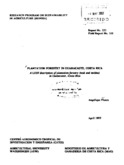| dc.contributor.author | Floors, A. | |
| dc.date.accessioned | 2014-10-18T02:38:23Z | |
| dc.date.available | 2014-10-18T02:38:23Z | |
| dc.date.issued | 1997 | es_ES |
| dc.identifier | 352924 | es_ES |
| dc.identifier.uri | https://repositorio.catie.ac.cr/handle/11554/3408 | |
| dc.description | 2 fig. 8 tab. 18 ref. Sum. (En). También como Field Report - Atlantic Zone Programme (CATIE) no. 161 | es_ES |
| dc.description.abstract | REPOSA (Research Programme on Sustainability in Agriculture) is a cooperation between different departments of the Wageningen Agricultural University, Centro Agronomico Tropical de Investigación y Enseñanza (CATIE) and the Ministerio de Agricultura y Ganadería (MAG) of Costa Rica. In this case the creation of LUST's on plantation forestry with teak and melina in Guanacaste, Costa Rica are described. A LUST (Land Use System at a defined Technology) description is formed by a chronological and quantitative description of a particular operation sequence (e.g., nutrient application). Deforestation rate during the past 60 years has been very high in Costa Rica. In 1986 a subsidy was introduced to promote reforestation. In 1989 an other subsidy for reforestation was introduced especially aiming at reforestation by small farmers. An amount of 600 is paid per hectare for establishment. The subsidy is one of the main reasons why 4000 hectare per year of teak, melina and pochote have been planted in Guanacaste during the past few years. Data on management and production were collected. Each management activity for teak and melina is described for different sites (site index exponente 1 high, middle or low). Management activities for teak and melina are the same. Differences exist in the period when activities have to be executed. Management activities e.g., thinning and pruning are necessary for an optimal tree growth. Site index is influenced by environmental factors like climate, soil type and slope. Teak and melina have different perequisities conserning climate, soil type and slope. Each of these environmental factors is briefly discussed. Volume estimations for teak and melina were made for thinnings and for the final cut. Corrections for wind and for an irregular tree form are included in the volume estimations. For major soil types in Guanacaste the suitability for teak and melina was estimated according to field observations. | es_ES |
| dc.language.iso | en | es_ES |
| dc.publisher | CATIE, Turrialba (Costa Rica). Atlantic Zone Programme Agricultural University Wageningen, Wageningen (Países Bajos) Ministerio de Agricultura y Ganadería, San José (Costa Rica) | es_ES |
| dc.subject | PLANTACION FORESTAL | es_ES |
| dc.subject | TECTONA GRANDIS | es_ES |
| dc.subject | GMELINA ARBOREA | es_ES |
| dc.subject | UTILIZACION DE LA TIERRA | es_ES |
| dc.subject | REFORESTACION | es_ES |
| dc.subject | TERRENO EN DECLIVE | es_ES |
| dc.subject | SOSTENIBILIDAD | es_ES |
| dc.subject | COSTA RICA | es_ES |
| dc.title | Plantation forestry in Guanacaste, Costa Rica: a LUST description of plantation forestry (teak and melina) in Guanacaste, Costa Rica | es_ES |
| dc.type | MON | es_ES |
| dc.identifier.publication | Turrialba (Costa Rica) | es_ES |


